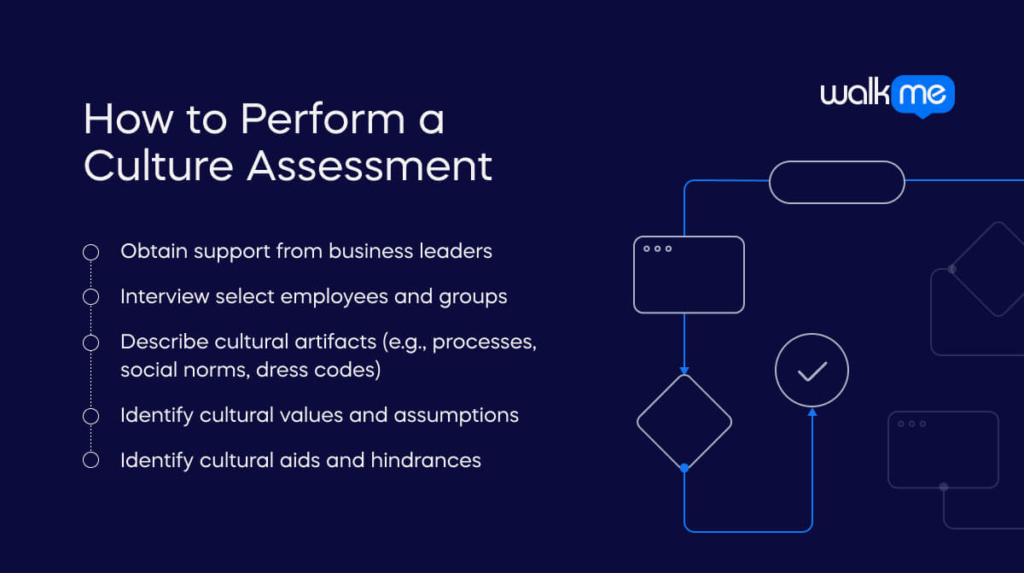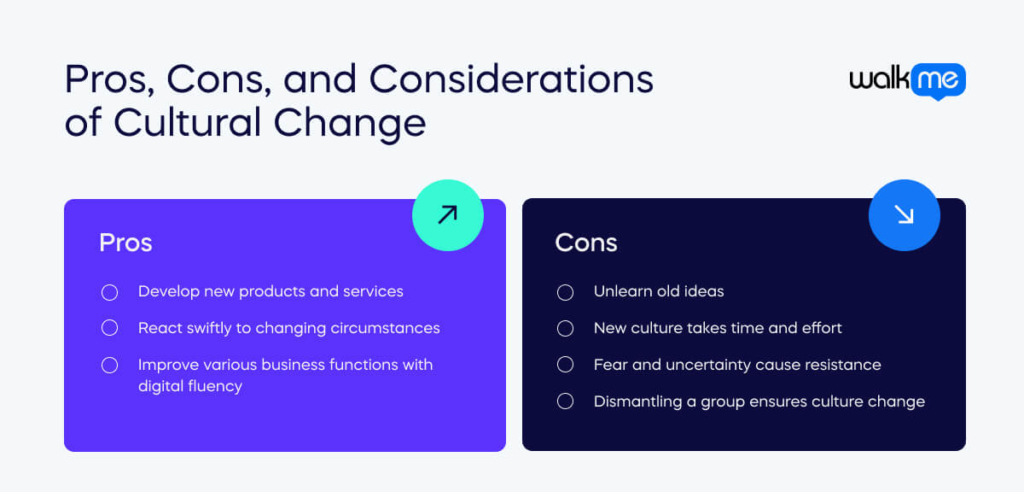What is the relationship between organizational culture and change?
The answer will be different, depending on a few things, such as:
- The nature of the change initiative
- Its goals
- How that change will affect employees
- The corporate culture itself
In other words, to answer this question, you will have to assess your own circumstances.
Below, we will explain:
- What organizational culture is
- How it affects things such as employee attitudes, behaviors, and performance
- How to assess and understand your own culture
- What “the best” culture is in today’s fast-paced world
Let’s start with the most fundamental concept, organizational culture itself.
Organizational Culture: What It Is and Why It Matters
Organizational culture is defined differently by different people.
However, many definitions revolve around:
- Beliefs, values, and assumptions
- Social norms and rules of conduct
- The attitudes and behaviors of groups
Many things help to create an organizational culture, such as:
- The founders’ mission and philosophy
- The beliefs, values, and culture of new employees
- The collective experience of employees
- Organizational changes and developments
All of this helps us to understand what organizational culture is.
Now we need to learn how this information applies to change management.
The Relationship Between Organizational Culture and Change
As mentioned, the relationship between organizational culture and change will vary depending on the situation.
That is, culture can:
- Positively impact a change initiative
- Negatively impact a change initiative
- Or have little to no effect
Cultural change should not be the primary goal of a change project.
The main goals of any change initiative should be business goals.
Changing corporate culture should be a secondary aim, if and when a culture interferes with the proposed change.
A digital transformation program, for instance, shouldn’t attempt to adjust culture unless the existing culture obstructs that project’s goals.
To determine when culture changes are appropriate, organizations should start by assessing their culture.
How to Perform a Culture Assessment

Before you can decide whether culture will hinder your change objectives, it’s important to understand your own corporate culture.
Here’s how:
- Obtain buy-in and support from business leaders
- Interview select employees and groups
- Elicit descriptions of cultural artifacts (manifestations of culture, such as processes, social norms, dress codes, and so forth)
- Identify the values and assumptions of the culture
- Identify cultural aids and hindrances
Finally, compile and analyze this information.
These interviews will help you determine which parts of a culture will hinder or help a change project.
And, by collaborating with stakeholders and business leaders, you can decide whether culture change is necessary or desirable.
Pros, Cons, and Considerations of Cultural Change

The right organizational culture can significantly improve a business in many ways.
For instance, in today’s fast-paced global economy, certain business characteristics are desirable:
- Innovative businesses can develop new products and services
- Agile companies can react more swiftly to changing circumstances
- Organizations that are digitally fluent can improve a wide variety of business functions
Cultures that contribute to such business characteristics, therefore, would also be very valuable.
However, cultural change is not easy.
In fact, it is, by definition, difficult and taxing.
Here’s why:
- Employees must unlearn previous ideas – which is almost always disconcerting and psychologically painful
- Reestablishing a new culture takes time, energy, and effort – which often causes fatigue (commonly known as “change fatigue”)
- Fear, anxiety, and uncertainty often turn into resistance – making the situation more taxing for everyone involved
- The only certain way to change a culture directly is to dismantle a group – new processes and rules can affect behavior, but not necessarily culture
Finally, success is not guaranteed.
In fact, unless the change practitioner is experienced and has a long track record of success, the chances of failure are high.
For reasons such as these, it is important to carefully weigh the pros and cons of transformational cultural change proposals.
A Learning Culture – The Best Culture for Today’s World
In today’s fast-paced, complex world, change is constant.
A culture that can change and evolve quickly could easily be seen as a strong plus.
But this presents us with a paradox – strong cultures are, by definition, stable and conservative.
A culture that can change quickly, therefore, would seem to be the opposite.
However, a “learning culture” could be the solution to this problem.
According to Edgar Schein, a learning culture would:
- Emphasize proactive learning and problem-solving
- Believe that learning is a good thing
- Trust in people and believe that they can and will improve themselves over time
- Be oriented towards the future, not the present or the past
- Commit to a pragmatic search for truth
Among other things.
Such a culture would have the benefits of stability and cohesion. Yet it would still be malleable, adaptable, and agile.
Final Thoughts
Organizational culture reflects the beliefs, values, and attitudes of an organization.
That culture can clearly change over time, gradually and organically.
It can also be deliberately engineered through processes such as:
- Employee training
- Long-term organizational development
- Short-term transformational changes
Such initiatives carry their own risks, rewards, and uncertainties, which should be assessed critically before starting a cultural change program.
For those that do choose to engage in cultural change, perhaps the best trait to cultivate is one of perpetual learning.
As we saw, such a culture could help an organization become more agile, adaptable, and profitable in today’s complex world.

